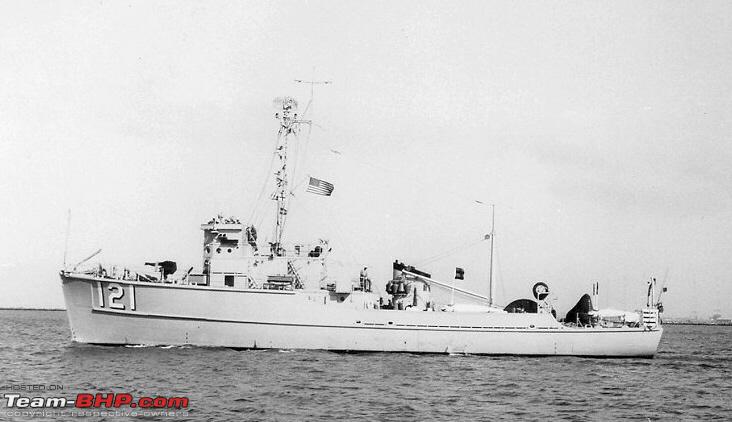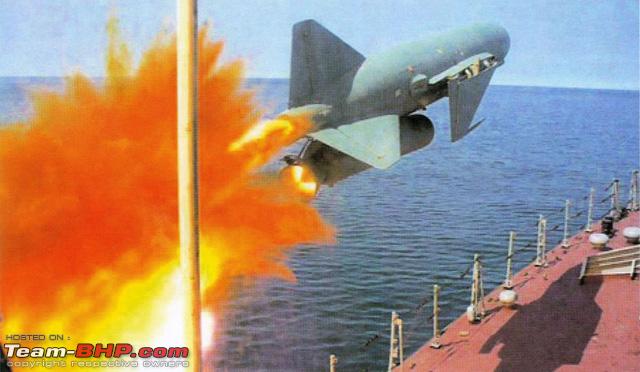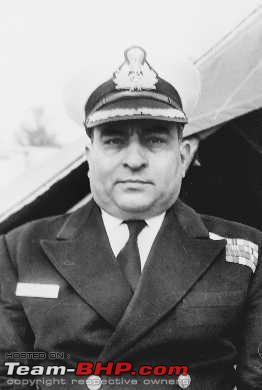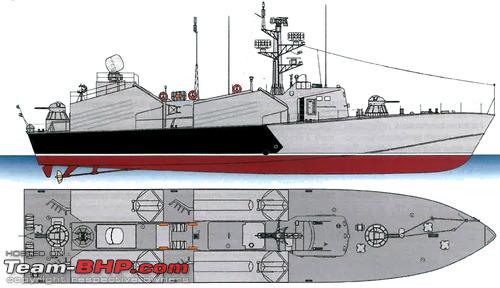| |||||||
| Search Forums |
| Advanced Search |
| Go to Page... |
 |
| Search this Thread |  293,069 views |
| | #301 | |||
| Senior - BHPian Join Date: Aug 2017 Location: Leeds
Posts: 1,045
Thanked: 2,515 Times
| Re: The Indian Navy - Combat Fleet Quote:
Quote:
Quote:
I'm less up to speed on the marine turbine space but where does RR fit in? I'd imagine GE has a major share of the pie (both military and civilian marine turbine sales). Forgive me if this has been discussed already but I was wondering. The struggles with a bleeding edge aerospace turbine domestically made by China are well documented but how have they fared when it comes to their efforts in the marine turbine space? Considering the sheer volume and pace of their shipbuilding industry (both civ+mil), I'm guessing they have workable domestic options in service? | |||
| |  (2)
Thanks (2)
Thanks
 |
| The following 2 BHPians Thank ads11 for this useful post: | dragracer567, V.Narayan |
| |
| | #302 | |
| Distinguished - BHPian  | Re: The Indian Navy - Combat Fleet Quote:
The total market is less than 100 units annually. Marine gas turbines are used primarily on war ships and a few other types of ships. They have been used on ferries (e.g. Stena Discovery). As mentioned their biggest advantages is they require virtually hardly any warm up period. Within minutes (some time less) after starting they can produce 100% power. Large marine diesel, medium speed diesel, simply canít. Depending on size / type it might take several hours from start to full power. The gasturbine packs a huge amount of power in a very small volume and weight, which is interesting for ships, but needs very large air in- and outlets. Itís main disadvantage is they are not very fuel efficient compared to diesels. That was the main reason for instance for decommissioning the Stena Discovery and other commercial gas turbine vessels during the last 10-15 years. Not sure how easy it is to convert an aeronautical gas turbine design into a marine version. Jeroen | |
| |  (4)
Thanks (4)
Thanks
 |
| The following 4 BHPians Thank Jeroen for this useful post: | ads11, dragracer567, Gansan, V.Narayan |
| | #303 | |
| Senior - BHPian Join Date: May 2009 Location: Chennai
Posts: 4,563
Thanked: 5,676 Times
| Re: The Indian Navy - Combat Fleet Quote:
https://en.wikipedia.org/wiki/General_Electric_LM2500 Last edited by Gansan : 30th November 2022 at 23:34. | |
| |  (1)
Thanks (1)
Thanks
 |
| The following BHPian Thanks Gansan for this useful post: | V.Narayan |
| | #304 | |
| Senior - BHPian Join Date: Aug 2017 Location: Leeds
Posts: 1,045
Thanked: 2,515 Times
| Re: The Indian Navy - Combat Fleet Quote:
Are most existing designs then iterative updates that can be traced back from one model so to speak? Just going by what V.Narayan said earlier, seems the Zorya turbine is practically venerable in the sheer number of platforms it powers. Does having an electrical turbine make for a more reliable set up than having the gas turbine more directly connected to the propeller? | |
| |  (2)
Thanks (2)
Thanks
 |
| The following 2 BHPians Thank ads11 for this useful post: | dragracer567, V.Narayan |
| | #305 | |
| Distinguished - BHPian  | Re: The Indian Navy - Combat Fleet Quote:
The electrical version is often used to create more flexibility in power requirements. It’s easier and cheaper to sync up a couple of generators to supply power to the same grid. Then multiple mechanical geared turbines on one shaft. Combining diesel and gasturbines to power an electrical grid on a vessel is very often done tongetje the benefits of both diesel and gas turbine. You have decent power on the diesels, but just add the gasturbines to add a lot of power immediately and for a short while. That is similar to shore based electrical steam power plants, who often have a few gas turbine driven alternators for peak loads. Steam turbines are even worse than diesel when it comes to adjusting quickly to heavy loads. Also, many modern ships have these so called Azipod and Z pod drives. Basically a huge pod protruding from the hull of the ship with a build in emoter and propellor. These pods can rotate 360o, which gives these ships excellent manoeuvrable. These are always electrical driven, at least the larger ones are. I have sailed as engineer on a fire fighting Anchor Handling Tug. We had two fire monitor, both powered by a very simple gas turbine. About 2-3000BHP each. I can’t recall the make, but I do remember that it was a derivative from a gas turbine used on helicopters. Jeroen Last edited by Jeroen : 1st December 2022 at 00:44. | |
| |  (2)
Thanks (2)
Thanks
 |
| The following 2 BHPians Thank Jeroen for this useful post: | dragracer567, V.Narayan |
| | #306 | ||
| Senior - BHPian Join Date: Aug 2019 Location: BAH / MCT
Posts: 1,011
Thanked: 5,465 Times
| Re: The Indian Navy - Combat Fleet Quote:
 Quote:
| ||
| |  (3)
Thanks (3)
Thanks
 |
| The following 3 BHPians Thank dragracer567 for this useful post: | Jeroen, saikarthik, sierrabravo98 |
| | #307 |
| Distinguished - BHPian  Join Date: Aug 2014 Location: Delhi-NCR
Posts: 4,149
Thanked: 67,145 Times
| Re: The Indian Navy - Combat Fleet https://www.news18.com/news/india/na...s-6532681.html https://theprint.in/defence/indian-n...krant/1247125/ The Naval Chief says that the IN will consider a second vessel built to the ~42,000 tonne INS Vikrant design in favour of a grounds up IAC-2 of ~65,000 tonnes. Sensible decision in my view. Better to build an improved INS Vikrant - bigger elevators, please - than to take 15 to 20 years on a larger more complex grounds up design. Today, folks, is Navy Day. The day in 1971, 51 years ago, the Indian Navy launched its first of two successful attacks on Karachi harbour effectively blockading the port. This deserves a detailed post by itself :-) Constructive use of a lazy cool winter Sunday morning |
| |  (6)
Thanks (6)
Thanks
 |
| The following 6 BHPians Thank V.Narayan for this useful post: | ads11, dragracer567, petrolhead777, saikarthik, sierrabravo98, Simhi |
| | #308 | |
| Senior - BHPian Join Date: Aug 2019 Location: BAH / MCT
Posts: 1,011
Thanked: 5,465 Times
| Re: The Indian Navy - Combat Fleet Quote:
The envisaged timeline by CSL that seems to be floating around is 5 years which I doubt since even our destroyers of the same class take 6-7 years to build. The Vikrant cost around $2.9 billion which is a bargain for an aircraft carrier. For a non-apples-to-apples comparison, the INS Vikramaditya cost a cool $2.35 billion just to refurbish an old carrier. For another non-apples-to-apples comparison, our Visakhapatnam class destroyers cost $1.1 billion each (though these are really state-of-the-art). So, I'm guessing that the repeat order would likely be cheaper (taking inflation into account) given that most of the R&D is already done and changes will be limited to bigger elevators and perhaps stronger arrestor cables. Wonder what will they name it if this is approved. INS Vishal is reserved for the IAC II, perhaps they will bring back the Viraat name? Other points from The Print article, good to know that the Rafale/F/A-18 and the Predator B contracts are on track, these are crucial capabilities. Last edited by dragracer567 : 4th December 2022 at 12:52. | |
| |  (4)
Thanks (4)
Thanks
 |
| The following 4 BHPians Thank dragracer567 for this useful post: | ads11, MaheshY1, Simhi, V.Narayan |
| | #309 | |||
| Distinguished - BHPian  Join Date: Aug 2014 Location: Delhi-NCR
Posts: 4,149
Thanked: 67,145 Times
| Re: The Indian Navy - Combat Fleet Navy Day 4th December – the history behind the day. Operation Trident was an offensive operation launched by the Indian Navy on Pakistan's port city of Karachi during the Indo-Pakistani War of 1971. It saw the first use of anti-ship guided missiles in combat in the region. The operation was conducted on the night of 4th–5th December 1971 and inflicted heavy damage on Pakistani naval vessels and shore based fuel facilities. While India suffered no losses, Pakistan lost a minesweeper, a destroyer, a cargo vessel carrying ammunition, and some fuel storage tanks in Karachi. Another destroyer was also badly damaged enough to be eventually scrapped. India celebrates its Navy Day annually on 4th December to mark this operation. Operation Trident was followed up by a similar Operation Python three days later. In 1971 Karachi housed the headquarters of the Pakistan Navy and almost its entire fleet. Since Karachi was also the hub of Pakistan's maritime trade and the largest industrial city of Pakistan a blockade would be crippling for Pakistan's economy. The security of Karachi Harbour was predominant and it was heavily defended against any air or naval strikes. The port's airspace was secured by the strike aircraft based at airfields in the area. The Indian Navy deemed it unwise to send its World War II vintage cruisers to lay down a naval gun bombardment as they would be too slow and leave the ships vulnerable to a Pakistani air attack. In that era we did not have ship borne surface-to-air-missiles that could have provided some air defense and INS Vikrant, our sole aircraft carrier, had been deployed off the East Coast to blockade East Pakistan.  File photo of a Osa class missile boat. The two large cannisters on either side house the Styx guided missiles The IN decided to think out of the box and use its small coastal 209-tonne Osa class missile boats, which carried 4 Styx anti-ship guided missiles each, to bombard Karachi. These were small coastal vessels designed by the Soviets for harbour defense and Karachi was 600+ nautical miles {1100 odd kms} away which these missile boats were not capable of traversing through open ocean. So before hostilities commenced the IN towed the Osa missile boats to Okha, the small naval port at the western tip of Saurashtra from where Karachi was only ~340 kms a range well within the capability of these boats. Also with their top speed in excess of 38 knots {70 kmph} they could just about strike and return between dusk & dawn. On 4th December, what was now designated as the Karachi Strike Group was formed and consisted of the three boats called the Vidyut-class missile boats by the IN: INS Nipat, INS Nirghat and INS Veer, each armed with four Soviet made SS-N-2B Styx surface-to-surface missiles with a range of 74 km and ~500 kg warhead, two Petya-class anti-submarine corvettes: INS Kiltan and INS Katchall as anti-submarine and air defence escorts. The group was under the command of Commander Babru Bhan Yadav. As planned, on 4 December, the strike group reached 460 km south off the coast of Karachi, and maintained its position during the day, outside the surveillance range of the Pakistan Air Force. As Pakistani aircraft did not possess night-bombing capabilities, it was planned that the attack would take place between dusk and dawn. At 10.30 pm the Indian task group moved 330 km from its position towards the south of Karachi. Soon Pakistani targets, identified as warships, were detected to the north of the Indian warships.  File photo of PNS Khaibar in better days in British service. She was a3400 tonne destroyer armed with 6 4.5 inch guns, 10 Bofors 40mm guns, a bank of 5 torpedoes and an anti-submarine mortar. She represented the British state of the art ot the early 1950s INS Nirghat, the first to strike, sailed north at speed and once in range fired its first Styx missile at PNS Khaibar, a Pakistani Battle-class destroyer. Khaibar, assuming it was a missile from Indian aircraft, engaged its anti-aircraft systems. The missile hit the right side of the ship , exploding below the galley in the electrician's mess deck at 10.45 PM. This led to an explosion in the first boiler room. Subsequently, the ship lost propulsion. Observing that the ship was still afloat, INS Nirghat fired its second missile hitting PNS Khaibar in the second boiler room on the ship's starboard side rapidly sinking the ship and killing 222 sailors. PNS Khaibar, an ex-British Battle class destroyer was one of the two most powerful warships the Pakistani’s possessed at the time. Her loss so early in the war was crippling.  PNS Shah Jahan in earlier times in British service. She was a2500 tonne fast destroyer escort or what today are called frigates. After verifying two targets in the area northwest of Karachi, at 11.00 PM, INS Nipat fired two Styx missiles – one each at cargo vessel MV Venus Challenger and its escort PNS Shah Jahan, a C-class destroyer. Venus Challenger, was carrying American supplied ammunition for the Pakistani forces from Saigon. It exploded immediately after the missile hit, and eventually sank south of Karachi. The other missile targeted PNS Shah Jahan and damaged the ship very badly. It was eventually towed back to Karachi & scrapped.  File photo of a Adjutant class mine sweeper like PNS Muhafiz At 11.20 PM PNS Muhafiz, an Adjutant-class minesweeper, was targeted by INS Veer. A missile was fired and Muhafiz was struck on the left side, behind the bridge. It sank immediately before it could send a signal to the PNHQ killing 33 sailors. To confuse the Pakistani’s the crews of these ships, who had all been trained in the USSR, spoke to each other over radio in Russian! Thus the enemy did not realize the Indian navy was close at hand. Later the Western media claimed that Russians were manning the boats {implying Indians were not clever enough to do so!} little realizing in those days a large proportion of IN officers and Petty Officers were fluent in Russian. Meanwhile, INS Nipat continued towards Karachi and targeted the Kemari oil storage tanks, placing itself 26 km south of the Karachi harbour. Two missiles were launched; one misfired, but the other hit the oil tanks, which burned and were destroyed completely. With no casualties on the Indian side, this operation was considered to be one of the most successful in modern naval history up to that time post-World War II. To mark this victory, the Indian Navy annually celebrates Navy Day on 4th December.  File photo of the fleet tanker class of ships to which PNS Dacca belonged. A follow-up attack, Operation Python, was launched on the night of 8th/9th December 1971. A strike group consisting of one missile boat INS Vinash and two frigates INS Talwar & INS Trishul attacked the group of ships off the coast of Karachi. While India suffered no losses, Pakistani fleet tanker PNS Dacca was damaged beyond repair, and the Kemari Oil Storage facility was lost. Two other foreign ships stationed in Karachi were also sunk during the attack. Between Operations Trident and Python, and the Indian Air Force attacks on Karachi's fuel and ammunition depots, more than fifty percent of the total fuel requirement of the Karachi zone was reported to have been destroyed. Our bold deployment surprised the Soviets pleasantly. Later they told us their satellites had captured a part of the operation! Quote:
Quote:
Quote:
Last edited by Aditya : 5th December 2022 at 06:20. Reason: As requested | |||
| |  (59)
Thanks (59)
Thanks
 |
| The following 59 BHPians Thank V.Narayan for this useful post: | ads11, Ankur@VNS, aravindb_0711, arijitkanrar, ashking101, BRV, CaptCarrot, catchjyoti, DetonatoR, Dieseltuned, Doc_nerd, dragracer567, DrPriyankT, FiatDiesel, Foxbat, gismosin, GreenerPlanet, GTO, ike, itwasntme, jayakumarkp, kashesh, keroo1099, lancia_fanboy, MaheshY1, Maky, mallumowgli, matrix1984, MyLife_MyCar, naveenvenkatesh, navin, neelkumar, Old_Salt, poised2drive, psispace, ramjiramu, RaviK, RGK, Route66, saikarthik, sanjayrozario, sayakc, sbanerjee, shancz, SlowRider, Snowflakes, Sudeep Lakhotia, sukhbirST, sunilch, theqca, thewhiteknight, TorqMaster, Torque_Curve, travancore, TSIboy, vamsi.kona, Voodooblaster, WhiteKnight, whitewing |
| | #310 | ||
| BHPian Join Date: Mar 2018 Location: Bengaluru
Posts: 188
Thanked: 618 Times
| Re: The Indian Navy - Combat Fleet Quote:
Shows how a good plan along with out the box thinking can work wonders. Quote:
Western prejudices against India have always been strong. They would concoct any story but refuse to acknowledge India's successes (however big or small they were). Its so heartening to note that India has always countered these with actions and not words. Shows in the way the relationships have evolved. Please allow me to post a few pics of INS Chapal - a missile boat thats similar to the Vidyut (Osa I) class used for Operation Trident. INS Chapal was a Chamak class (Osa II class) missile boat (as per Wikipedia, its an improved version but very similar to the Osa I class). These boats did not take part in Operation Trident. They were actually inducted after the war. Posting here since these are very similar to the Vidyut class boats. She is displayed at the Karwar beach and you can go inside the boat. If you are in Karwar or even at Goa or Gokarna, do make time to visit this boat.  Here is the boat on static display. You can see the giant missile tubes (2 on each side) that housed the P15 Termit (Styx SS-N-2B) missiles. In the original Vidyut (Osa I) class, these tubes were more squared off (pic in Narayan Sir's post).  Inside one of the missile tubes which stored the P15 Termit missile. You can see the rails on which the missile rode before exiting the tube. The missile sat inside with its wings folded down. The boat carried 4 of them.  The controls of the 3 Zvezda M504B radial diesel engines.  Here is one of the Zvezda M504B radial diesel engines. These weighed about 5tons each and each had 42cylinders laid out as 6 cylinders per bank with 7 banks! They produced around 5000HP. The boat had 3 of them.  A P15 Termit missile on display. Notice the cuts on the main wings where they were folded before launch. Last edited by arijitkanrar : 6th December 2022 at 00:42. Reason: Fixed error with attachment. | ||
| |  (21)
Thanks (21)
Thanks
 |
| The following 21 BHPians Thank arijitkanrar for this useful post: | ashking101, badboyscad, catchjyoti, Dieseltuned, Doc_nerd, Foxbat, Gannu_1, Jeroen, Maky, Maverick_4662, naveenvenkatesh, poised2drive, saikarthik, sanjayrozario, sayakc, sbanerjee, shancz, Skyline_GT, sukhbirST, V.Narayan, Voodooblaster |
| | #311 | ||
| Distinguished - BHPian  Join Date: Aug 2014 Location: Delhi-NCR
Posts: 4,149
Thanked: 67,145 Times
| Re: The Indian Navy - Combat Fleet Thank you @arijitkanrar for sharing those photos of the Osa-II class INS Chapal. There are many great stories from the 1971 war that need to be told and re-told so that younger generations aka the wonderful energetic members & readers of Team BHP know their recent, and still living, history. Quoting below an old post of mine from an earlier thread of 2015. Quote:
Quote:
PNS Ghazi, a 2400-tonne Tench class US Navy submarine supplied to Pakistan in 1963 | ||
| |  (31)
Thanks (31)
Thanks
 |
| The following 31 BHPians Thank V.Narayan for this useful post: | aravindb_0711, arijitkanrar, badboyscad, BRV, catchjyoti, DetonatoR, Dieseltuned, DragonHawk, dragracer567, gismosin, Jeroen, kashesh, maddy42, Maky, matrix1984, Maverick_4662, milin, naveenvenkatesh, Old_Salt, pacman2881, RGK, sagarpadaki, saikarthik, sanjayrozario, sayakc, shancz, skanchan95, Sudeep Lakhotia, sukhbirST, theqca, Voodooblaster |
| |
| | #312 | |
| BHPian Join Date: Sep 2012 Location: Bombay
Posts: 722
Thanked: 1,178 Times
| Re: The Indian Navy - Combat Fleet Quote:
Thank you for an insightful piece of history which I am sure many of my generation would never have heard of. Another question that popped in my mind and apologies if I am being naive, "If our Navy was able to retrieve the log books and navigation records, obviously somebody had to dive inside the sunken submarine to retrieve this, so my query is did we make an effort to recover the bodies of the sunken soilders from the sub ? " As you rightly said keeping aside the clouds of war, after all they were men doing their duty as they deemed fit. Regards Diesel | |
| |  (1)
Thanks (1)
Thanks
 |
| The following BHPian Thanks Dieseltuned for this useful post: | dragracer567 |
| | #313 | |
| Distinguished - BHPian  Join Date: Aug 2014 Location: Delhi-NCR
Posts: 4,149
Thanked: 67,145 Times
| Re: The Indian Navy - Combat Fleet Quote:
| |
| |  (5)
Thanks (5)
Thanks
 |
| The following 5 BHPians Thank V.Narayan for this useful post: | dragracer567, saikarthik, shancz, skanchan95, theqca |
| | #314 |
| BHPian Join Date: Feb 2013 Location: Bombay
Posts: 126
Thanked: 349 Times
| Re: The Indian Navy - Combat Fleet It is always a pleasure to read your write ups. One of my old friends, who also happens to be a member of this forum, had the honour of serving as a gun direction officer during the operation you've mentioned above. Thanks once again. |
| |  (1)
Thanks (1)
Thanks
 |
| The following BHPian Thanks theqca for this useful post: | V.Narayan |
| | #315 | |
| BHPian Join Date: Sep 2012 Location: Bombay
Posts: 722
Thanked: 1,178 Times
| Re: The Indian Navy - Combat Fleet Quote:
Regards Diesel | |
| |  (1)
Thanks (1)
Thanks
 |
| The following BHPian Thanks Dieseltuned for this useful post: | V.Narayan |
 |





